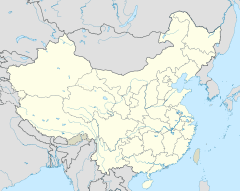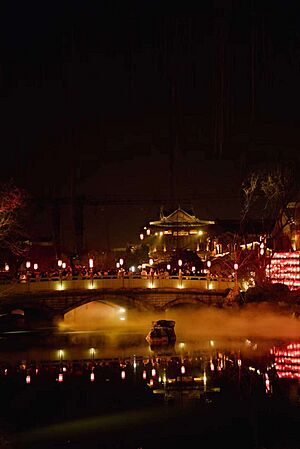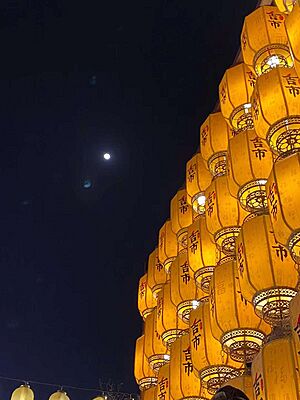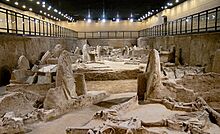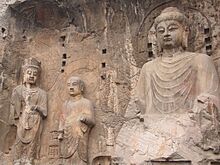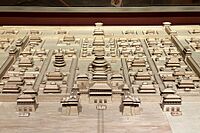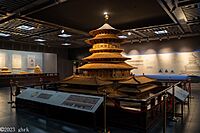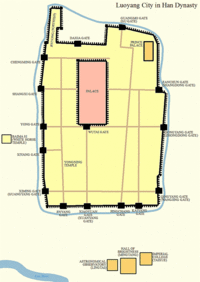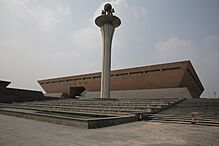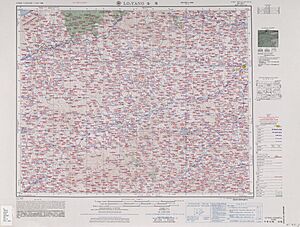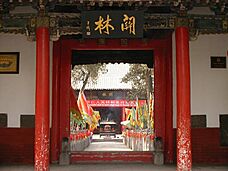Luoyang facts for kids
Quick facts for kids
Luoyang
洛阳市
Loyang
|
|
|---|---|
|
Prefecture-level city
|
|
|
|
|
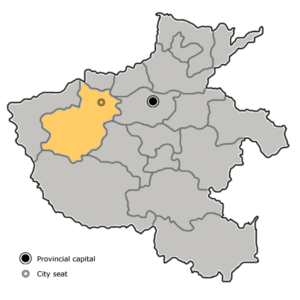
Location of Luoyang City jurisdiction in Henan
|
|
| Country | People's Republic of China |
| Province | Henan |
| Municipal seat | Luolong District |
| Area | |
| • Prefecture-level city | 15,229.15 km2 (5,880.01 sq mi) |
| • Urban | 810.4 km2 (312.9 sq mi) |
| • Metro | 1,402.3 km2 (541.4 sq mi) |
| Elevation | 144 m (472 ft) |
| Population
(2020 census, 2018 for otherwise)
|
|
| • Prefecture-level city | 7,056,699 |
| • Density | 463.36788/km2 (1,200.1173/sq mi) |
| • Urban | 2,249,300 |
| • Urban density | 2,775.54/km2 (7,188.6/sq mi) |
| • Metro | 2,751,400 |
| • Metro density | 1,962.06/km2 (5,081.72/sq mi) |
| GDP | |
| • Prefecture-level city | CN¥ 382.0 billion US$ 57.5 billion |
| • Per capita | CN¥ 56,410 US$ 8,493 |
| Time zone | UTC+8 (China Standard) |
| Area code(s) | 379 |
| ISO 3166 code | CN-HA-03 |
| Ethnicities | Han, Hui, Manchu, Mongolian |
| County-level divisions | 15 |
| License plate prefixes | 豫C |
Luoyang (simplified Chinese: 洛阳; traditional Chinese: 洛陽; pinyin: Luòyáng) is a large city in the western part of Henan province, China. It is located where the Luo River meets the Yellow River. Luoyang is a prefecture-level city, meaning it's a major city that also governs surrounding areas.
As of late 2022, Luoyang is home to about 7.079 million people. It is one of the oldest cities in China and is considered one of the places where Chinese civilization first began. It was also the very first of the Four Great Ancient Capitals of China.
Contents
- Understanding the Name of Luoyang
- Exploring Luoyang's Past
- UNESCO World Heritage Sites in Luoyang
- Ancient City Sites to Explore
- Luoyang's Administrative Divisions
- Luoyang's Geography and Climate
- Luoyang's Culture and Traditions
- Education in Luoyang
- Getting Around Luoyang
- Sister Cities of Luoyang
- Famous People from Luoyang
- See also
Understanding the Name of Luoyang
The name "Luoyang" comes from the city's location. It is on the "sunny" ("yang") side of the Luo River. Since the river flows from west to east, the sun always shines on the north side.
Luoyang has had many names over time, like Luoyi (洛邑) and Luozhou (洛州). During the Tang dynasty, it was called Dongdu (eastern capital). The only female emperor in Chinese history, Wu Zetian, called it Shendu (divine capital). In 1912, it got its main name, Luoyang, back.
Exploring Luoyang's Past
Luoyang has a very long and important history. It has been a special place since ancient times.
Early History of Luoyang
The area around Luoyang was considered the center of China. Because of this, many important cities were built here. Around 2070 BC, the Xia dynasty king, Tai Kang, moved his capital to this area.
Later, in 1600 BC, the Shang dynasty built a new capital called Western Bo near the Luo River. The ruins of this ancient city are still in Luoyang today.
Around 1036 BC, a settlement called Chengzhou was built. Another capital, Wangcheng, was built nearby. Wangcheng became the capital of the Eastern Zhou dynasty in 771 BC. You can still see the ruins of Wangcheng at Wangcheng Park today.
Luoyang During the Han Dynasty
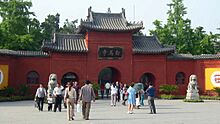
In 25 AD, Luoyang became the capital of the Eastern Han dynasty. It was a very important city for several centuries. In 68 AD, the White Horse Temple, which was the first Buddhist temple in China, was built here. This temple still stands today.
Luoyang was also the eastern end of the famous Silk Road during the Han dynasty. This made it a key place for trade and cultural exchange.
Luoyang in the Wei and Jin Dynasties
After a period of trouble, Luoyang became important again in 220 AD. Cao Pi, the first emperor of the Wei dynasty, made it his capital. The Jin dynasty also had its capital in Luoyang. At its peak, Luoyang had a population of 600,000 people.
However, in 311 AD, the city was attacked and destroyed. For the next 200 years, Luoyang was not a major city.
The Northern Wei Dynasty and Luoyang
| Luoyang | |||||||||||||||||||||||
|---|---|---|---|---|---|---|---|---|---|---|---|---|---|---|---|---|---|---|---|---|---|---|---|

"Luoyang" in Simplified (top) and Traditional (bottom) Chinese characters
|
|||||||||||||||||||||||
| Simplified Chinese | 洛阳 | ||||||||||||||||||||||
| Traditional Chinese | 洛陽 | ||||||||||||||||||||||
| Literal meaning | "Northern Bank of the Luo [River]" | ||||||||||||||||||||||
|
|||||||||||||||||||||||
In 493 AD, Emperor Xiaowen of Northern Wei moved his capital to Luoyang. He brought over 150,000 people to the city. He also started building the amazing Longmen Grottoes, which are caves filled with Buddhist statues carved into rock. More than 30,000 statues from this time have been found there.
The Shaolin Temple was also built near Luoyang to house an Indian monk. The Yongning Pagoda, which was the tallest pagoda in China, was also built in Luoyang.
Luoyang in the Sui and Tang Dynasties
When Emperor Yang of Sui took power in 604 AD, he built a new Luoyang city.
During the Tang dynasty, Luoyang was known as "Dongdu" (the "Eastern Capital"). It was a huge city with about one million people, second only to Chang'an, which was the largest city in the world at that time.
Empress Wu Zetian, China's only female emperor, moved her capital to Luoyang. She built the tallest palace in Chinese history there.
Luoyang in Later Times
During the North Song dynasty, Luoyang was the "Western Capital." It became an important center for culture and philosophy.
After the Yuan dynasty, Luoyang was no longer the capital of China. The city was rebuilt several times. In 1949, Luoyang's population was about 75,000 people.
Luoyang in Modern China
After the People's Republic of China was formed, Luoyang became a major industrial city. Many large factories were built here. This industrial growth brought many new people to Luoyang. Today, about half of Luoyang's population are new residents or their families who moved there after 1949.
UNESCO World Heritage Sites in Luoyang
Luoyang is home to several places recognized by UNESCO for their global importance.
- Longmen Grottoes: These amazing rock carvings were added to the World Heritage List in 2000.
- The Grand Canal: Parts of this ancient waterway, including the Huiluo Barn and Hanjia Barn, were added in 2014.
- Silk Roads: Important sites along the Silk Road, like the Han Wei Luoyang City Site, were also added in 2014.
Ancient City Sites to Explore
Luoyang has many ruins of ancient cities.
- Erlitou Site (Zhenxun) from the Xia dynasty.
- Yanshi Shang City Site (Xibo) from the Shang dynasty.
- Wangcheng Site from the Eastern Zhou dynasty.
- Luoyang City Site from the Han and Wei dynasty.
- Luoyang City Site from the Sui and Tang dynasty.
Luoyang's Administrative Divisions
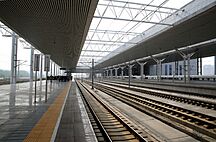
Luoyang is divided into 7 districts and 7 counties.
- Districts
- Jianxi District
- Xigong District
- Laocheng District
- Chanhe Hui District
- Luolong District
- Yanshi District
- Mengjin District
- Counties
- Xin'an County
- Luoning County
- Yiyang County
- Yichuan County
- Song County
- Luanchuan County
- Ruyang County

Recent Changes to Luoyang's Map
In 2021, Luoyang's city area was made larger. This was done to help with planning and to connect Luoyang better with the nearby city of Zhengzhou. Some areas like Yanshi and Jili were merged into urban districts. This change effectively doubled the size of Luoyang's urban area.
Luoyang's Geography and Climate
Luoyang's old town is on the north bank of the Luo River. The modern city covers both sides of the river and some nearby mountains.
Most of the land around Luoyang is hilly or mountainous. Mountains make up about 45% of the area, and hills make up about 40%.
Luoyang's Weather
Luoyang has a climate with dry winters and humid summers. The weather can be very hot in summer and very cold in winter. Temperatures have ranged from -18.2°C (about -0.8°F) to 44.2°C (about 111.6°F).
| Climate data for Luoyang (Yanshi District) (1991–2020 normals, extremes 1951–2010) | |||||||||||||
|---|---|---|---|---|---|---|---|---|---|---|---|---|---|
| Month | Jan | Feb | Mar | Apr | May | Jun | Jul | Aug | Sep | Oct | Nov | Dec | Year |
| Record high °C (°F) | 22.2 (72.0) |
24.3 (75.7) |
31.2 (88.2) |
38.5 (101.3) |
41.9 (107.4) |
44.2 (111.6) |
41.9 (107.4) |
41.7 (107.1) |
40.3 (104.5) |
35.2 (95.4) |
28.6 (83.5) |
23.5 (74.3) |
44.2 (111.6) |
| Mean daily maximum °C (°F) | 6.5 (43.7) |
10.5 (50.9) |
16.5 (61.7) |
23.3 (73.9) |
28.5 (83.3) |
32.9 (91.2) |
33.0 (91.4) |
31.3 (88.3) |
27.4 (81.3) |
21.9 (71.4) |
14.6 (58.3) |
8.4 (47.1) |
21.2 (70.2) |
| Daily mean °C (°F) | 1.0 (33.8) |
4.5 (40.1) |
10.2 (50.4) |
16.7 (62.1) |
22.1 (71.8) |
26.7 (80.1) |
27.8 (82.0) |
26.3 (79.3) |
21.8 (71.2) |
15.9 (60.6) |
8.7 (47.7) |
2.8 (37.0) |
15.4 (59.7) |
| Mean daily minimum °C (°F) | −3.2 (26.2) |
−0.4 (31.3) |
4.9 (40.8) |
10.7 (51.3) |
16.2 (61.2) |
21.3 (70.3) |
23.7 (74.7) |
22.4 (72.3) |
17.4 (63.3) |
11.2 (52.2) |
4.1 (39.4) |
−1.4 (29.5) |
10.6 (51.0) |
| Record low °C (°F) | −17.3 (0.9) |
−18.2 (−0.8) |
−9.9 (14.2) |
−3.6 (25.5) |
1.9 (35.4) |
11.8 (53.2) |
16.5 (61.7) |
12.9 (55.2) |
6.9 (44.4) |
−2.4 (27.7) |
−8.6 (16.5) |
−14.9 (5.2) |
−18.2 (−0.8) |
| Average precipitation mm (inches) | 7.7 (0.30) |
10.3 (0.41) |
19.4 (0.76) |
33.5 (1.32) |
49.0 (1.93) |
64.6 (2.54) |
113.9 (4.48) |
95.9 (3.78) |
69.4 (2.73) |
37.1 (1.46) |
24.4 (0.96) |
5.1 (0.20) |
530.3 (20.87) |
| Average precipitation days | 3.5 | 3.9 | 4.9 | 5.6 | 7.3 | 7.7 | 10.4 | 10.0 | 8.7 | 6.5 | 5.2 | 2.8 | 76.5 |
| Average snowy days | 3.7 | 3.2 | 1.0 | 0.2 | 0 | 0 | 0 | 0 | 0 | 0 | 0.9 | 2.4 | 11.4 |
| Average relative humidity (%) | 59 | 58 | 55 | 58 | 59 | 59 | 73 | 76 | 72 | 68 | 67 | 60 | 64 |
| Mean monthly sunshine hours | 133.6 | 141.5 | 177.3 | 204.7 | 220.4 | 204.4 | 182.5 | 176.7 | 153.3 | 151.3 | 145.7 | 146.4 | 2,037.8 |
| Percent possible sunshine | 43 | 45 | 48 | 52 | 51 | 47 | 42 | 43 | 42 | 44 | 47 | 48 | 46 |
| Source 1: China Meteorological Administration | |||||||||||||
| Source 2: Weather China data.ac.cn | |||||||||||||
Luoyang's Culture and Traditions
Luoyang is a city rich in culture and history.
Famous Cultural Sites
- The Longmen Grottoes are south of the city. They are a UNESCO World Heritage Site.
- Guanlin is a group of temples built to honor Guan Yu, a famous hero from the Three Kingdoms period.
- The White Horse Temple is about 12 km (7.5 mi) east of the city.
The Luoyang Museum (started in 1958) has ancient items from the Xia, Shang, and Zhou dynasties. China's only tomb museum, the Luoyang Ancient Tombs Museum, opened in 1987.
The Gaocheng Astronomical Observatory is southeast of Luoyang. It was built in 1276 to measure the sun's shadow. This helped ancient Chinese astronomers understand the seasons.
Ideas and Inventions
Luoyang is a very important place for Chinese thought and inventions.
- It is where Confucianism began.
- It is the birthplace of Taoism.
- It was the first place where Buddhism was widely shared in China.
- Three of the Four Great Inventions of ancient China – the compass, paper making, and printing – were developed here.
- Many Chinese family names started in Luoyang.
Delicious Food
The "Water Banquet" is a famous traditional meal in Luoyang. It has 8 cold dishes and 16 warm dishes. All the warm dishes are cooked in broths or gravies. The name "Water Banquet" means that the dishes have soup and that they are served smoothly, like flowing water.
Beautiful Peonies
Luoyang is famous for its beautiful peonies, which are its city flower. Every year in mid-April, the city holds the Peony Culture Festival of Luoyang. Millions of tourists visit to see the flowers.
Music and Language
An old Chinese song called "Spring in Luoyang" is very popular. It is even performed in Korea.
People in Luoyang usually speak a dialect of Zhongyuan Mandarin. This dialect was once a very important way of speaking Chinese, from the Zhou dynasty until the Ming dynasty.
Education in Luoyang
Luoyang has several universities and colleges.
- Luoyang Institute of Science and Technology (洛阳理工学院)
- Henan University of Science and Technology (河南科技大学)
- Luoyang Normal University (洛阳师范学院)
- PLA Foreign Language Institute (解放军洛阳外语学院)
Getting Around Luoyang
You can reach Luoyang by highways, trains, or planes. High-speed trains are a very popular way to travel to the city from places like Xi'an or Zhengzhou.
Luoyang has a bus system with over 30 lines. Taxis are also easy to find.
Subway System
Luoyang has a subway system. Line 1 opened in March 2021, and Line 2 opened in December 2021.
Train Stations
- Conventional Trains: The main station is Luoyang railway station.
- High-speed Trains: Luoyang Longmen railway station serves high-speed trains.
Roads and Highways
Major highways connect Luoyang to other cities.
- G30 Lianyungang–Khorgas Expressway
- G36 Nanjing–Luoyang Expressway
- G55 Erenhot–Guangzhou Expressway
- China National Highway 207
- China National Highway 310
Airport
Luoyang is served by Luoyang Beijiao Airport.
Sister Cities of Luoyang
Luoyang has special partnerships with other cities around the world. These are called "twin towns" or "sister cities."
 La Crosse, Wisconsin, United States
La Crosse, Wisconsin, United States Okayama, Okayama, Japan
Okayama, Okayama, Japan
Famous People from Luoyang
Many notable people have come from Luoyang throughout history. Here are a few:
- Bai Juyi, a famous poet and politician from the Tang dynasty.
- Ban Chao, a diplomat and general from the Eastern Han dynasty who helped reopen the Silk Road.
- Cao Cao, a powerful leader and poet during the Han dynasty.
- Chen Dong, a modern Chinese astronaut.
- Di Renjie, a smart politician from the Tang dynasty.
- Laozi, a legendary thinker who founded Taoism.
- Wu Zetian, the only female emperor in Chinese history.
- Xuanzang, a Buddhist monk who traveled to India and is famous from the story Journey to the West.
- Wang Yibo, a popular actor and singer.
- Zhang Heng, a brilliant scientist and statesman from the Han dynasty.
See also
 In Spanish: Luoyang para niños
In Spanish: Luoyang para niños







